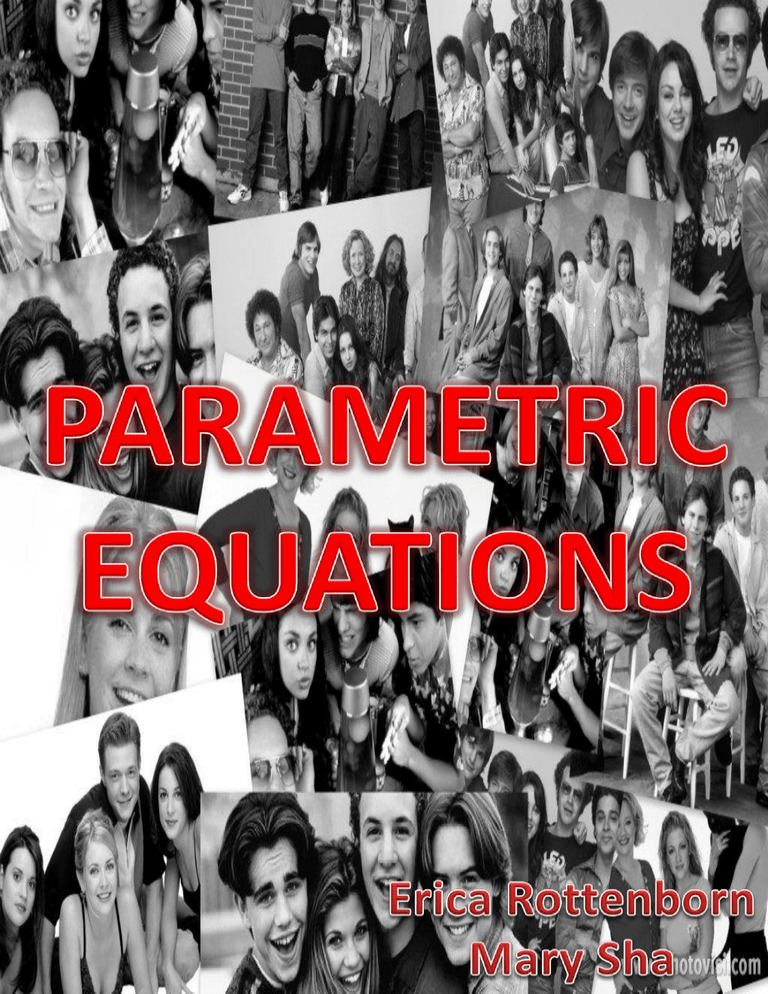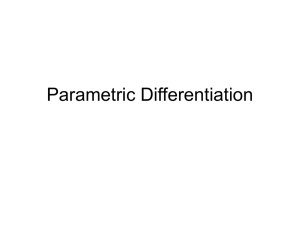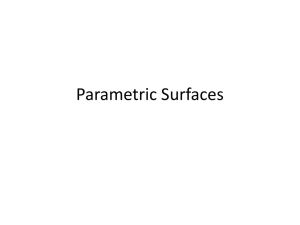Find the tangent line
advertisement

Topanga’s Real-World Applicability……………………………. Pg.3 Hyde’s Helpful Mathematician’s Contributions………….. Pg.4 Angela’s Analytical Examples…………………………............ Pg.5-8 Midge’s Multiple Choice Example…………………………….. Pg.9-10 Cory’s Conceptual Example………………………………………. Pg.11 Foreman’s Arc Length with Graphing Calculator………. Pg.12-13 Mr. Feeny’s Free Response Example………………………... Pg.14-16 Sabrina’s Works Cited………………………………………….…….Pg.17 How many times have you seen a cat walk in the path of x²? Almost never. Cats (like Salem) pounce, jump, and walk in circles. However, there are no functions to describe Salem’s movement. By incorporating time into a function, parametric equations allow us to describe these paths of movements that we could not describe before. One function relies on time, t, to describe the movement with respect to x, and the other function relies on time, as well, to describe the movement with respect to y. Together, they give you graphs that can describe movement we could not describe before like the movement of the eight ball as Cory and Shawn play pool or the path of Forman’s smoke. Mustapha Amrani is a professor at the University of Cambridge and is affiliated with the Isaac Newton Institute. He studies parametric equations in detail so as to find real-world applications for the concept and he gives talks on his findings. Amrani has discovered a use of parametric equations that was previously unknown-- he has begun to incorporate parametric equations and semi-parametric equations into electricity consumption forecasting. For utilities it is necessary to have a good idea of the future's electricity consumption and Armani has found that through the use of parametric equations in his work he is able to better predict the consumption trends that will occur thereby aiding the utilities. Since Armani uses primarily semi-parametric structures he is able to create an even more accurate prediction as his models create a complex but interesting trade-off between previous accurate forecasts and new adaptations to different data sets. Although these contributions are still gaining credibility and usage in the real-world, Armani has proven how parametric equations can be utilized with a multitude of different geographical climates and horizons in order to try to accurately predict the electricity consumption of the future. First, let’s learn how to eliminate the parameter. Eliminating the parameter allows for you to go from parametric equations to polynomial equations. Ultimately we are eliminating time, t, from the equation. x (t ) t 3 t3 So, when told to eliminate the parameter, look at the x and-y functions and decide in which equation would it be easier to solve for time, t. Although both of the equations above are quite messy, the y-equation seems to be easier to solve for time, t. 2 y 1 t 2 2 4 2y t 2 4 2y t The last step is to solve for time, t, in the y-equation and plug it in for time, t, in the x-equation. You just eliminated the parameter! Wasn’t that easy? Graph and find the equation of the tangent line to the graph at t=1 if x(t)=2t²-4 and y(t)=t²-3t+1 First, let’s graph the parametric equation! Graphing parametric equations are quite different from regular equations. Because the equations are given with respect to time, we are actually calculating positions at certain times. So, you would want to create a table of values like the one to the bottom-left and graph the points by plugging time into the x- and y-functions. For example, at t=0, the x-value is -4 and the y-value is 1. So, the first point will be (4,1). Continue this with the rest of the points. Also, one thing greatly different from regular graphs is direction. So add an arrow to specify what direction you are going. t 0 x(t) -4 y(t) 1 .5 1 -3.5 -2 -.25 -1 1.5 2 .5 4 -1.25 -1 Now, it’s time to find the tangent line! When finding tangent lines, it’s not too different from regular equations. First, find the derivatives of both x- and y- functions. x ' (t ) 4 t y ' (t ) 2 t 3 Next, it’s time to find the slope of the tangent line. But, how do we do this when we have two functions!?!? You simply divide the derivative of the y-function by the derivative of the x-function. dy / dt dx / dt y ' (1) x ' (1) 2 (1) 3 1 4 (1) 4 Now that we have the slope of the tangent line, it’s time to find the x- and y-coordinates. This step is a bit more straight forward. Just plug in t=1 into the functions! x (1) 2 (1) y (1) (1) 2 2 4 2 3 (1) 1 1 Finally, it’s time to put it all together and graph the tangent line! y 1 1 ( x 2) 4 y 1 1 ( x 2) 4 Now you know how to graph parametric equations and find their tangent lines! At which time, t, does the graph of 𝒙 𝒕 = 𝟐𝒄𝒐𝒔(𝒕𝟐 ) and 𝒚 𝒕 = 𝒔𝒊𝒏𝟐𝒕 have a vertical tangent line on the interval −𝟏 ≤ 𝒕 ≤ 𝟐? a. 0 b. 𝜋 c. 2 d. 0, 𝜋 e. 0, 𝜋, 2 To find a vertical tangent line, we must solve for when the derivative of the x-function is equal to zero. This will give us the time at which there is no movement in the x-direction and thus a vertical tangent line! x ' ( t ) 4 t sin t 0 4 t sin t t0 2 2 sin t 2 0 t 2 So what will make this equation equal to zero? Obviously when t is equal to zero, the whole function will be zero so that is one option. When sine is zero, the whole function will be zero as well. At 0 and 𝜋, sine is equal to zero but because we already have 0, we can consider 𝜋. t t0 t We now have the two times at which there is no movement in the x-direction. So we’re done now right!? Well not quite. We have to test these times in the derivative of the y-function and make sure it does not equal zero. Why may you ask? Well, what’s happening to the graph when both the derivative of x and y are zero? That’s right, nothing. There’s no movement, and therefore, there wouldn’t be a vertical tangent line at that moment. y ( t ) sin 2 t y ' ( t ) 2 cos 2 t y ' ( 0 ) 2 cos( 2 ( 0 )) y ' ( ) 2 cos 2 2 Now that we have established that there is still movement at those times, we can officially say we have gotten our answer! The times at which a vertical tangent line occurs are at 0 and 𝜋. Letter A doesn’t work because it only has 0, Letter B only has 𝜋, Letter C doesn’t have either, and Letter E has too many answers. The only answer that matches our choice is Letter D! 1 . 840 What is the concavity of the graph of 𝒙 𝒕 = 𝟏𝟏𝒕𝟐 + 𝒆−𝒕 and 𝒚 𝒕 = 𝟑𝒕 − 𝟏 at time, t=-3? Once you hear the word concavity, immediately think the second derivative! Wait, but how do we take the second derivative of a parametric function? First we find the first derivative which we already learned how to do. Differentiate the x- and y-functions then set dy over dx. This is the first derivative. Now differentiate the first derivative to get the second derivative, but wait a second! The second derivative is in terms of dt! It should be in terms of dx²! To solve this problem just divide the second derivative we just found by dx. Then evaluate at t=-3! dx 22 t e dy t dt dt dy / dt dx / dt d d dy dx 3 3 22 t e t dy t t t dx 22 t e 0 3 22 e 3 22 e t 2 t 2 dt ( 22 t e ) ( 22 t e ) dy dx 2 dt dx dx dt 2 2 2 3 22 e t t 2 ( 22 t e ) 3 ( 22 e ) 1 22 t e t 3 d y dx d y t 3 ( 22 ( 3 ) e ) 3 3 0 Because the second derivative evaluated at t=-3 is greater than zero than the graph is concave up! If the eight ball Eric hit is described in inches by the 𝟒 functions 𝒙 𝒕 = 𝟐 + 𝒕 and 𝒚 𝒕 = 𝟕𝒕𝟑 − 𝟏𝟐, what is the 𝒕 distance the eight ball traveled between time t=1 and t=3? To find the distance the eight ball traveled, we will want to use the arc length equation. 𝑏 𝑥′(𝑡)2 + 𝑦′(𝑡)2 𝑑𝑡 𝐴𝑟𝑐 𝑙𝑒𝑛𝑔𝑡ℎ = 𝑎 So first, we need to find the derivatives of the x- and y-functions. x ' (t ) 8 t 3 1 y ' ( t ) 21 t 2 Now just plug in the derivatives into the arc length equation and solve it by using your graphing calculator! 3 1 2 8 2 1 21 t 3 t 2 dt The eight ball that Eric hit traveled a total distance of 182.138 inches! Sabrina is practicing spells with her aunts Zelda and Hilda when-OH NO!--she accidentally hits Salem with a jumping jinx! Salem begins to jump uncontrollably with an initial velocity of 40 ft/sec at angle of 75° to the ground. Despite his efforts to acquiesce to the 32ft/sec acceleration of gravity he is unable to stop jumping. If Salem was initially resting 3ft above the ground on the arm of the couch, create X(t) and Y(t). To begin to find the position functions you must utilize the general equations: 𝑉𝑥𝑜 = 𝑉𝑜 cos𝜃 V𝑦𝑜 = 𝑉𝑜 sin𝜃 First focus on finding X(t). Substitute the information from the problem into the general equation to get the velocity function for X. V𝑥(𝑡) = 40𝑐𝑜𝑠75° Next, integrate the equation to get the position function for X. 𝑉𝑥(𝑡) 𝑑𝑡 = 40𝑐𝑜𝑠75°𝑑𝑡 𝑋(𝑡) = 40𝑐𝑜𝑠75° 𝑡 Now that you have found X(t), focus on finding Y(t). Integrate the acceleration function to get the velocity of Y. 𝐴𝑦(𝑡) 𝑑𝑡 = −32 𝑑𝑡 V 𝑡 = −32𝑡 + 𝐶 Add the constant of integration that you get from the general equation for the velocity of Y. 𝑉 𝑡 = −32𝑡 + 40𝑠𝑖𝑛75° Integrate the velocity function to get the position function of Y. 𝑉 𝑡 𝑑𝑡 = −32𝑡 + 40𝑠𝑖𝑛75°𝑑𝑡 𝑌 𝑡 = −16𝑡 2 + 40𝑠𝑖𝑛75° 𝑡 + 𝐶 Add the initial condition. 𝑌 𝑡 = −16𝑡 2 + 40𝑠𝑖𝑛75° 𝑡 + 3 The final answer is: 𝑋 𝑡 = 40𝑐𝑜𝑠75° 𝑡 𝑌 𝑡 = −16𝑡 2 + 40𝑠𝑖𝑛75° 𝑡 + 3 Eliminate the parameter: t 2) x ( t ) 1)𝑥 𝑡 = 4𝑡 + 1 𝑦 𝑡 = 2𝑡 − 1 t 1 y (t ) t 1 3 3) 𝑥 𝑡 = 𝑡 2 + 1 y (t ) 3t 2 t 1 4 Graph the following parametric equations: t 3 2 4) x ( t ) t 6) x ( t ) 5) x ( t ) t 2 3 t y (t ) 2 t 1 y (t ) t 2 t 2 3 2 t 3 3 t 4t 4 y (t ) 3 Find 𝒅𝒚 7) x ( t ) t 2 3 t y (t ) 2 t 3 3 𝒅𝒙: 8) x (t ) 1 t t 4 2 2 y ( t ) ln( t 2 ) 2 1 3 Find the tangent line: 9) At t=2: 10) At t=1: x (t ) t 4 t 6 x ( t ) 4 t 3t 5 3 2 y (t ) 1 y ( t ) 7 t 10 t 2 2 t 5 2 4 11) At t=3: x ( t ) ln( 2 t 3 t 5 ) 2 y (t ) t 5t 7 3 12) If 𝑥 = sin 𝑡 and 𝑦 = −cos 𝑡, then 𝑑2𝑦 𝑑𝑥 2 (A) − 3 (D) 3 2 (B)−3 3 (C) 0 𝜋 6 at t= equals (E) 3 13) What is the length of the path described by the parametric equations 𝑥 𝑡 = 2𝑒 𝑡 − 5 and 𝑦 𝑡 = 3𝑡 2 + 6, where 0 ≤ 𝑡 ≤ 5? (A)309.122 (B)36.993 (C)325.687 (D)39.046 (E) 369.826 14) The velocity vector of a particle moving in the xy-plane is given by 𝑣 𝑡 =< 4𝑡 2 − 3𝑡 + 1, 3𝑡 − 2 >. At t=0, the particle is at the point (0,-1). What is the position vector at t=3? (A) < 27,8 > (B)< 8,27 > (C)< 6.5,25.5 > (D)< 25.5,6.5 > (E) < 25.5,7.5 > 15)At what time(s) t does the graph of 𝑥 𝑡 = 5𝑡 2 − 2𝑡 and 𝑦 𝑡 = 3𝑡 + 1 have a vertical tangent line? (A) 0 & 2/5 (B) None of the above (C) 0, 2/5, 1/5 (D) 1/5 (E)-1/3 16) Find the speed of a particle traveling along the path of 1 𝑥 𝑡 = 4𝑡 3 − 3𝑡 + 1 and 𝑦 𝑡 = 𝑡 2 + 𝑡 at t=2. 2 (A) 7.348 (B)27.295 (C)45.100 (D)2601 (E)93.134 Cory and Topanga’s relationship has had up and downs and everything in between over the years. The path of their love is modeled by the velocity vector 𝑑𝑥 −1 𝑑𝑦 𝑒−1 < = sin 𝑡 + 𝑒𝑡 , = 18𝑡 2 cos(𝑡 3 ) − 2𝑡 > 𝑑𝑡 4 𝑑𝑡 for 0 ≤ 𝑡 ≤ 3 and at t=0 the position of their love is (3,0). a) Find the speed of the particle and the acceleration vector at t=2. b) Find the x-and y-values of their love at t=2. c) Find the equation for the line tangent at t=2. d) Find the length of their love from t=0 to t=3. C P A E L R C M U I L T A T T E O D R http://25.media.tumblr.com/tumblr_md045fV4d51rb7hiho1_r1_1280.jpg http://assets.nydailynews.com/polopoly_fs/1.1209162!/img/httpImage/image.j pg_gen/derivatives/landscape_635/article-boymeetsworld-1127.jpg http://static.tvtropes.org/pmwiki/pub/images/boymeetsworld.jpg http://images6.fanpop.com/image/photos/32400000/Wallpaper-that-70s-show32443974-1280-720.jpg http://www.ruthlessreviews.com/wp-content/uploads/2006/03/70sshow.jpg http://assets.nydailynews.com/polopoly_fs/1.1123285.1343424691!/img/httpI mage/image.jpg_gen/derivatives/gallery_635/70-show.jpg http://images.fanpop.com/images/image_uploads/Sabrina-the-Teenage-Witchsabrina-the-teenage-witch-477153_1920_1536.jpg http://static.tvtropes.org/pmwiki/pub/images/Sabrina.gif http://geoffgould.net/sabrina.jpg http://static.tvguide.com/MediaBin/Content/121029/News/6_sat/thumbs/1211 03boy-meets-world1_300x206.jpg https://i.chzbgr.com/maxW500/4693711360/hF1B775DE/ http://lukeyboi6.tripod.com/ http://sabrinatheteenagewitch.wikia.com/wiki/Sabrina_Spellman http://cdn.static.ovimg.com/episode/63411.jpg http://flavorwire.files.wordpress.com/2012/11/bmw.jpg Multiple-Choice & Free-Response Questions in Preparation for the AP Calculus (BC) Examination by David Lederman











